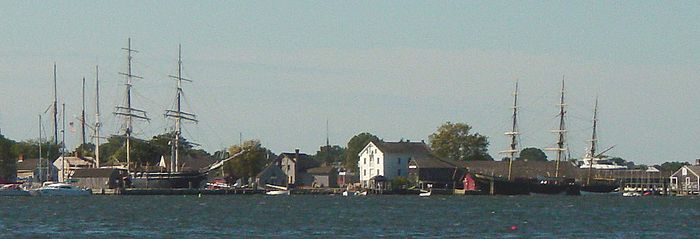Mystic Seaport
Mystic Seaport in Mystic (Connecticut) ( USA ) is an open-air museum founded in 1929 on the Mystic River with an integrated museum harbor and a maritime museum . It is operated in the concept of living history , the most important object is the whaler Charles W. Morgan .
Overview
The museum was founded in 1929 under the name "Marine Historical Association". In 1941 it became known nationwide with the acquisition of Charles W. Morgan , the last wooden whaler . Affiliated are a research center, the Frank C. Munson Institute of American Maritime Studies , other advanced training facilities and one of the largest shipping libraries in the world. The Mystic Seaport was one of the first museums in the United States to be built on the principle of "Living History". The depicted place consists of more than 60 original buildings, most of them are rare, originally commercial buildings. These were dismantled at their original locations and rebuilt here. In many of these houses, craftsmen reproduce the form of the work processes of a nineteenth-century seafaring town. The museum is visited by around 400,000 visitors a year.
port
The collection of ships includes among other things
- the Annie , a sand dredger , d. H. an over-rigged racing boat with sand ballast from 1880
- Charles W. Morgan , built in 1841, sailed to Boston on her 38th voyage in 2014
- the Emma C. Berry , a sloop rigged fishing and cargo boat from 1866
- the Joseph Conrad ex Georg Stage , a former Danish sailing training ship from 1882, rigged as a full ship
- the Sabino , the last wooden American ship with steam engine propulsion, built in 1908 as a passenger ferry
- the Breck Marshall , a replica of a catboat
- the Australia , an 1862 schooner
- the Brilliant , a racing yacht from 1932
- the Estella A , a sloop built in Maine in 1904
- the Florence , a fishing boat from 1926
- the Gerda III , a Danish wooden lighthouse supplier from 1926 who played an important role in the evacuation of Jewish refugees from Denmark during World War II
- the LA Dunton , a 1921 schooner used in Newfoundland cod fishing
- the Kingston II , a 1937 harbor tug - one of the first fully welded vessels to serve in the shipyard and port of Groton
- the Nellie , an oystercatcher rigged as a sloop from 1891
- the Regina M. , a sloop-rigged fish truck from Passamaquoddy Bay, built around 1900
- the Roann , a 1947 trawler ( rig-dragger ) from New England
- the Star , a 1950 Connecticut fishing boat used to catch swordfish, tuna, and lobsters
Some of the ships shown are the last of their kind in existence. Four of the ships have been classified as National Historic Landmarks , the Charles W. Morgan , the LA Dunton , the Emma C. Berry and the Sabino . The museum harbor also offers overnight berths for ships that do not belong to the museum.
building
Almost all trades that are generally associated with the creation and operation of a fleet can be visited in the village . Each building serves to depict the original activities, but the products that were created there are also explained. These include the ship chandler , the candle maker , the Reeperbahn , the cooperage , the ship agent's office , the printer , the nautical instrument shop and much more. A replica of Nantucket's Brant Point lighthouse is also on site .
The shipyard is another important part of the place. Here ships are restored in the traditional way or the museum's ships are maintained. There are also replicas of important ships, such as the Amistad . More than 100,000 ship drawings and plans have been archived here.
In another, not true to the original houses additional items such as a model of the Mystic River area are around 1870 in 1/128 or figureheads issued in the Planetarium which is Astronavigation explained.
Culture
The Mystic Seaport Sea Music Festival has been held on the site every June since 1979 and is one of the oldest and largest festivals of its kind in North America. Music is also performed outside of this festival, so shanties are presented in their context as work songs. Port employees also recruit guests to set sails or move a spill to the rhythm of the songs .
reception
- In the book Mystery of the Whale Tattoo of the Hardy Boys series, Mystic Seaport plays an essential role, one of the main characters is almost killed on board the Charles W. Morgan , a statue essential to the plot is found there again.
- In 1997, Mystic Seaport was used as the backdrop for many scenes in the film Amistad .
- The music group Vampire Weekend refers to this place in their song Walcott .
Illustrations
literature
Maynard Bray, Benjamin Fuller, Peter Vermilya: Mystic Seaport Watercraft . 3. Edition. Mystic Seaport Museum, 2001, ISBN 0-913372-94-3 (English).
Web links
Individual evidence
- ↑ Image of the ship on the museum's website ( Memento of the original from June 24, 2016 in the Internet Archive ) Info: The archive link was inserted automatically and has not yet been checked. Please check the original and archive link according to the instructions and then remove this notice.
- ↑ Website of the Historic Naval Shios Association ( Memento of the original from January 20, 2010 in the Internet Archive ) Info: The archive link was inserted automatically and has not yet been checked. Please check the original and archive link according to the instructions and then remove this notice.
- ↑ Illustration on the museum website
- ↑ Photos on the museum website
Coordinates: 41 ° 21 ′ 45 " N , 71 ° 57 ′ 55" W.







